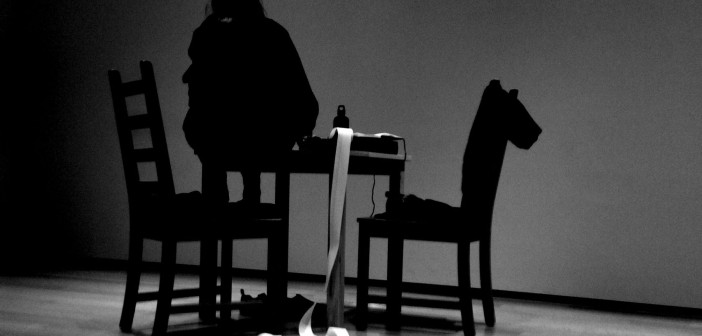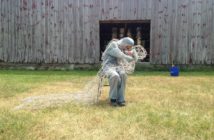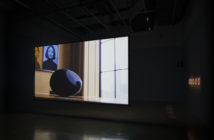Exploring time in a new way every day within 6-hour durations through the show 100 Ways to Consider Time at the Museum of Fine Arts, Marilyn Arsem challenges audience members to contemplate time as a material. This multifaceted work of performance art incorporates the fascination Arsem has for time; its malleability and our ever-shifting perception of what it is and what it can be. She is working with a set of potentials, and each day within Gallery 261 she is testing the constants and variables of new actions in her performances.
Arsem comes to the gallery every day with a new piece in mind, ranging from quiet, contemplative and minimal works to more interactive pieces in which the audience is asked to contribute to the fabric of the work through participation. Rather than working with a single action for the 100 day length of the work, Arsem mindfully pursued the astronomical challenge of developing a new work each day with no repeats of previous days work in order to push beyond what is known and into the realm of the unknown. Whether the work is to be viewed as one performance or one hundred performances is something to be contemplated. All of the works from each of the first fifty days challenges time, questions its structure and fluidity, and explains that time can actually be considered, and reconsidered, built up and broken down, resurrected or erased.
The work presents a unique experience for Boston locals and visitors to engage with a durational performance piece over time. What is true about this work is that those who witness it and continue to return to see more of it over days, weeks, and months have the opportunity to watch ideas, time and space unfold. It is rare that we give ourselves the time in our daily lives to contemplate time as an idea, as a structure that defines what we do, to consider that time is how we gauge our success, our failures; time is the mark of both the beginning and the end of our lives, time is every ticking second between those points. Time could be everything that came before and everything that will exist beyond us.
The audience members who stay the longest may have found that there is a profound way in which the work of Arsem allows the space for contemplation of one’s own relationship to time. I am always struck by the thoughts and memories from the distant past that feel so present when I have viewed performances on various days, and how raw and arresting that can be all at once. There is a merging of past, present and anticipation of future moments all activated by Arsem’s actions within the space. On an individual level, one has to be willing to take the time necessary for something to unfold or it could all be missed.
An audio recording of Arsem’s voice plays through the gallery space each day before beginning a new work that describes the performance of the previous day. In the audio, she recalls in a straightforward manner the time spent the previous day and remarks about her ideas and experiences of it. The recordings vary in their duration and play in the gallery for 30 minutes or 3 hours depending on the day of the week. After she leaves the space physically at the end of a 6-hour session, a new audio is uploaded for the next day. In this way, Arsem is present in the gallery even when her body is absent.
For each hour, on the hour, a chime of a grandfather clock echoes through the space which marks both the end of a segment of time and the beginning of a new one. For the spaces between the chime, there is ticking: faint but distinct. Once the ticking is noticed it feels akin to an itch that cannot be ignored. The seconds can feel like hours and the awareness that the gallery space promotes regarding the fleeting nature of time is challenging. And then there are moments where the ticking can exist further away from the focus of our awareness, and the focus can be emphasized elsewhere. The clock audio alternates between being on and off according to the parameters of the performance that day.
For the first day of her performance, Arsem set the tone for the forthcoming days with the undertaking: to enter the space. She spent the full six hour duration entering the room of the 261 Gallery of the Contemporary Art Wing at the Museum of Fine Arts, Boston. With remarkable slowness, she walked from the doorframe to the farthest corner of the room. In the corner was her chair where she sat only for brief moments before the 6 hours were complete. To think about the amount of spaces that we enter within a given day, then to consider the same for weeks or months and the time that we take to do that is fascinating. We are constantly entering spaces without total awareness of what our body is experiencing in these both internal and external spatial shifts. The consideration is usually an after thought. To enter a space is to take a leap of faith; we always hope we will find what we are looking for in whatever form that may take.
The second day of the performance, Arsem alternated between sitting and walking around the gallery space while counting out loud. There were moments when the audience was called on to assist in the recollection of the numbers that had already been counted. The audience became active participants, seeking to assist in keeping track of the ‘present’ moment by being completely aware of what had come before. As the numbers increased, I became aware of how long it takes to physically call out a number, versus the time it takes to write, type or have a computer generate the number. I was also aware of how much time it took to say a number versus the quantifiable time that had actually passed. At the end of the 6 hours, Arsem had counted to 5,800. The seeming arbitrariness of that number speaks to the limit of what can be achieved in a set duration, and beautifully stands as a metaphor for life itself. Our desires for things to line up, to be categorized, to make sense does not change the simple fact: most things we cannot force, foresee, or know.
On the third day, Arsem positioned an hourglass on a table in front of her, where the audience was able to watch an hours worth of sand grains pass through one of the glass bulbs to the other. When an hour had been completed and one of the bulbs was depleted, she would delicately, with a single hand movement, grip and turn the glass upside down to allow the falling of the sand grains to begin again. She would take a small rock from a line she had made along the left side of the table, and place that rock in front of the hourglass, forming a line of 6 rocks in total to represent the passage of the 6 hours of the performance. What was profound was thinking of the grains of sand within the hour glass and how they might one day through fusion and time become the small rocks, and at the same moment to consider the reserve: the small rocks might one day be reduced to the grains of sand within the hour glass. Whichever comes first, the fusion or the breakdown, the beginning or the end; it is all within the manner in which we decide to perceive it. Interesting to consider that both options exceed our lifetimes.
Watching a sphere of ice melt on top of a table was the tenth day of the performance. The accumulation of the melted water sat on top of a black cloth, and created a reflective surface in which the immediate space and audience members who walked up to Arsem could see their own faces in the water. This day I was contemplating mortality, and the inability to predict when the end really is. At the end of the six hours, the sphere of ice had only partially melted.
On the eleventh day, Arsem measured pieces of tape the length of her body, cut them, and placed them on the floor. She then sat down on the floor parallel to the tape and positioned rocks on her shins, thighs and stomach. After the rocks were in place, she reclined and laid back onto the floor. She pressed a timer that began to take record of the time that was passing while the rocks remained on her. After several minutes of waiting, her body would cause one of the rocks to fall as a result of trembling muscles. When the rock would fall off her body and hit the wooden floor, she would stop recording the time and mark the place where the rock had fallen off with a piece of blue tape. She would write onto the tape the amount of time that it took for the rock to fall, and which attempt it was. At the end of the six hour duration, the entire space was covered in interconnecting lines of blue tape and only small slivers of floor remained untaped. The image is a visual representation of all the data and systems that exist around us that we might not have access to. Energy cannot be created nor destroyed, but ideas and information continue to grow at exponential rates.
Approximately 11 miles was the distance that Arsem walked in the gallery space on the twelfth day of her performance. She walked around the perimeter of the room, hands behind her back, or letting them fall at her sides, then running her finger across the wall as she maintained her pace. While she made her rounds she made some exchanges with the audience. The open dialogue permitted the audience to ask questions. Arsem’s movement evoked the poignant feeling of stillness within myself, as I sat and watched her move. I thought about 11 miles in slow circles in a confined space, versus 11 miles walking around the city; 11 miles as set goal versus 11 miles just happening to be how long something went on for. Reminiscent of a prisoner walking in a cell, or a child pacing in a ‘time out’, I felt the frustration and the anticipation of the end. I considered whether the end of the performance was the 11 mile marker, or the conclusion of the six hour time frame.
Day thirteen Arsem spent balancing rocks. The objective was to stack the rocks on top of one another, and to see how high the pile of rocks could get before it would fall over, before repeating it again. The constant trial, resulting in the falling of the rocks over and over again was mesmerizing. It surely was known by everyone in the room that eventually by the addition of the second or third rock that a fall of the lot would happen, and yet there was still the desire to see the inevitable through. The falling of the rocks holds a parallel to the way that events in life unfold. Just when there is some stability, something else is added on and the balance is thrown off. The question has to be asked: try again? We spend most of our lives trying again. And again, and again, and again. Our realities are like the stacked rocks; always fragmentary moments away from rupture.
“What was the longest day of your life?’ was the question posed on day twenty-two of the performance. The words were typed out individually on sheets of computer paper and hung together in a line on the wall. The audience sat at the bench across from the question and considered their answers before sharing them with Arsem and the collective audience there at the time of their response. Some knew right away what they wanted to say, and shared freely. Stories varied from lighthearted memories to more intense ones, and ranged from a few words to elaborate retellings. The structure of this piece allowed people to feel that they could share, in front of strangers, without it turning into a confessional. The energy in the space was that of an unofficial contract between audience members that seemed to be rooted in unwavering respect for the performance and the stories of others, no matter how that unfolded or manifested. I remember entering the space and seeing the question on the wall; I stayed in the space for 2.5 hours and still was not able to answer the question.
On day twenty-three. Arsem brought a roll of paper spanning 150 feet in length into the room with the objective of cutting the paper in half ‘forever’. There was a list on the wall stating the integers that the paper would accumulate to each time it was cut in half. So if a piece of paper was cut into two, the next goal would be to reduce those two sheets to four sheets, and so on. Then the result would be recorded on the paper on the wall, and the next series of cuts would happen. This sheet was marked with the time of completion when all the pieces were the same size. The work became participatory, as the audience members got down on their knees in the middle of the gallery space and assisted with the cutting and piling of the paper pieces. Some audience members counted the stack of paper to make sure the numbers matched with a list of numbers Arsem had listed on the wall. At 9:30pm the total count of on the pieces of paper was 1,024.
The walls were lined with a single sheet of paper, pressed in at the corners of the room and stopped at the opening of the doorway on day twenty-nine. Arsem methodically walked around the room, arm extended at her side, and griped a bright colored pastel as she pressed it into the wall to make a document of her movement. When she would get to the doorway where the paper ended she would hold the pastel on the paper in the place of her last mark while transferring it to another hand to continue the line from the exact place it had been left off. After the transfer of hands, she continued onwards, and accumulated such an immense amount of lines that it began to look like static if one stayed with the image long enough. Every 30 minutes the color was switched, but the line always began at the place of the last marking. Audience members sat on the bench, and when Arsem passed by them in her way around the space she incorporated the outline of their upper body into the work. The outlines over people’s heads were reminiscent of waves or the rhythms revealed in electrocardiography charts. Some members stayed so long that there were obvious outlines in the work where a body had been present for hours. One was reminded of the way that we really only understand time in lines because it directly relates to a timeline which is perceived to be a graspable amount of time to consider. I thought about beginnings and endings, especially when colors were alternated. What would happen at the end of this accumulation?
“What was the happiest day of your life?” was the question presented on the wall on day thirty. In a similar aesthetic to the other questions, the words were printed on single pieces of printer paper and hung up in a line across the gallery wall. The floor was covered in large sheets of rolls of paper. Immediately, after audience members entered the space, and sometimes when they were still reading the question on the wall, they were approached and had their feet outlined with a pen on the floor labeled with a time which was the exact hour and minute in which they had entered the space. The outline of the participants feet marked the time people came, and after telling a story and leaving the space, Arsem would record the time that they had left. What became apparent over the hours I stayed and observed was that people’s perception of their happiest moments were often not dressed up stories, but seemingly mundane, and all the more beautiful for it, recollections. Audience members spoke of times when they were floating in water, experiencing the birth of a child, surrounded by the people they loved most. It was moving to hear the memories articulated and unfolding in real time, that strangers were willing to open up and to talk on a personal level in front of one another.
There was an empty glass positioned on the table for day thirty-seven of the performance. Arsem sat at the table, which was positioned in the center of the room to stare at the glass. Upon entering the space, it was clearly visible that there was no fluid or material in the glass. Immediately, thoughts of loss and longing surfaced. It is possible to consider the glass as a metaphor for the human body; when it is filled up there is life and the function appears more clear, but when it is emptied out, it has experienced a loss and what is left is the vessel. At the end of our life, we leave the body behind, until that also decomposes over time. Overall, the empty glass was a visual means to get the audience to consider emptiness. One could consider the emptiness of space, the gaps in our understanding, and perhaps the emptiness we confront within ourselves.
Upon entering the space on day thirty-eight the audience was confronted with the following: “CAN YOU HEAR YOUR PAST? CLOSE YOUR EYES AND LISTEN. HOW FAR CAN YOU HEAR?” Arsem was sitting on the floor, about four feet away from the wall and alternated between looking at the questions that hung on the wall and looking at the floor or tucking her head into her chest. The space was quiet, without much foot traffic or audio from the other pieces within the wing going off, which made contemplation of these questions possible. In unison the audience members closed their eyes and went into their memories to experience how far back they could actually hear. For me, memories of the distant past were jumbled, mixing up voices with other faces, homes from certain locations now in different far off places, and left fragments as the main source of what I could get at. There was a wall that I was coming up against, that I could not penetrate beyond, which I believe to be age four. After ‘hearing the past’, audience members were encouraged to approach the table, which Arsem had left one chair at for people to sit in. The audience would take a seat, and were prompted by a sign at the table which read: “WHAT DID YOU HEAR?” On the table there was a sheet of paper with a pen, space to record, but already filled with writings in multiple languages, drawings, poetry, stories, and single words. Some of the stories moved me with their raw and unassuming honesty. All the recordings were anonymous.
With only an hour left of the performance on day thirty-nine, I approached gallery 261 and saw Arsem on the floor with 10 rocks in a line. She was closest to the wall directly across from the larger viewing bench. As I settled in, I noticed her reach to move a rock from the end of the trail of rocks to the front of the line. She then took another rock from the end of the rock line and moved it to the front. And again, and again. Each time she did this she systematically made sure that the spacing between the rocks was minimal, and that even though they were barely touching there was consistency in that. She continued to move across the space, moving rocks from the end of the line to the front. When she reached the wall she began a line parallel to the existing line, which moved further across the space and continued to take rocks from the back, and moved them to the front across the room again. It became apparent that she had spent 6 hours moving across the floor, and was following the lines of the floorboards. She wanted the entire floor to have been touched by the rocks by the end of the six hour duration. Because of the movement of the rocks and the system of doing it in lines that gradually spaced apart, it brought up ideas of rock formations: time, pressure, buildup, breakdown, burying and resurfacing.
A table, positioned in the corner upon entering the space was set up with a computer, printer and a set of blank certificates with an eager Arsem on the other side. A large sign hung on the front of the table: ‘FREE TIME’ for day forty-four. “I’m giving away free time, so you will need to think about what you want.” she would tell the alternating viewers who either stood in the doorway of the space to try to gauge what was happening or took a seat and patiently waited their turn. Requests ranged from a few extra hours in the day, to infinite time. After the request was made, Arsem would enter the request into a certificate format on her computer and present it to the audience member to make sure their request was accurate. After receiving confirmation from them, she proceeded to print the document and signed it. When her pen hit the paper she would look at the recipient and say, “I am signing this, so now it is official”. Some people were so moved by the certificate that they wanted to have one made for people that were not able to attend the performance that night; Arsem worked diligently with the audience members to create free time for those who could not be present.
On day fifty, I entered the space to find Arsem sitting on the tabletop with a receipt paper calculator pressing down on a single button over and over again. When she pressed down, she was entering each breath (inhalation and exhalation) that she took. The calculator formed a record of these breaths, which printed out as integers of +1. As time passed, the tape stretched across the floor and made its way over to the bench where the audience positioned themselves to see the work unfold. She alternated between sitting on the table to sitting in the chair. A few times an hour, Arsem held her breath after challenging the audience to hold theirs as long as they could. She outlasted just about everyone that accepted her challenge. 3,444 breaths in 6 hours was the end result.
What Arsem has undertaken in this performance is nothing short of an outstanding example of the ways in which time can be expanded, minimized, recalled, in the distance or hauntingly present.
‘100 Ways to Consider Time’ is currently on view at the Museum of Fine Arts, Boston until February 19, 2016. There is also an e-book available on the Museum of Fine Arts Boston website, which consists of documentations of Arsem’s international works and writing from curators Edward Saywell and Liz Munsell. This is the first of a two-part series from Chelsea Coon; a consideration of the last 50 days is forthcoming.
- ‘Breaths’, Day 50 in ‘100 Ways to Consider Time’, Marilyn Arsem Photo Credit: Vela Oma





